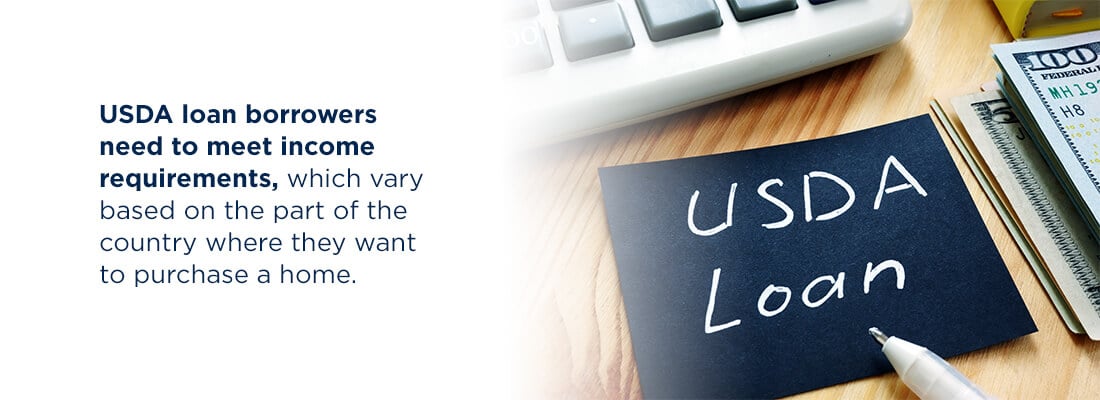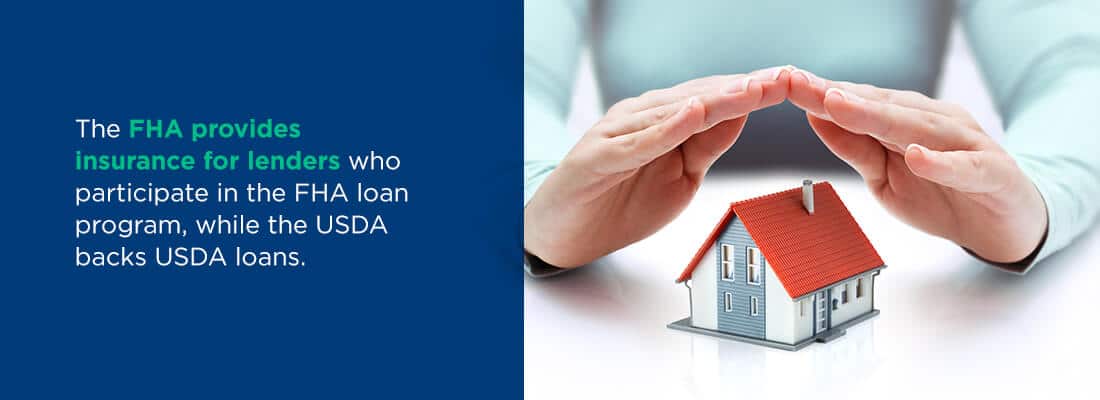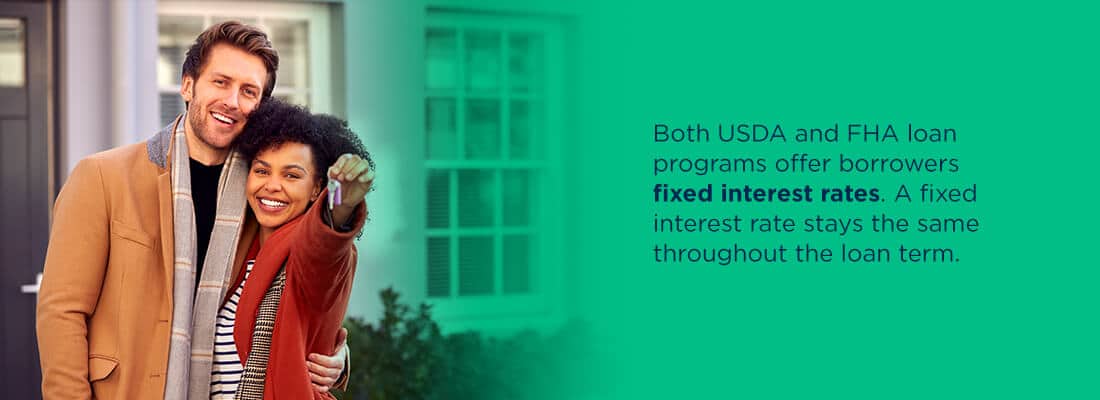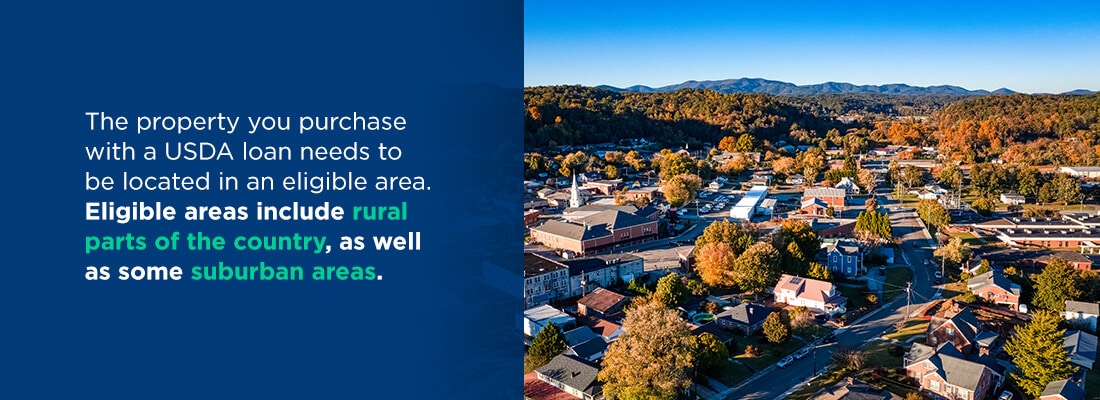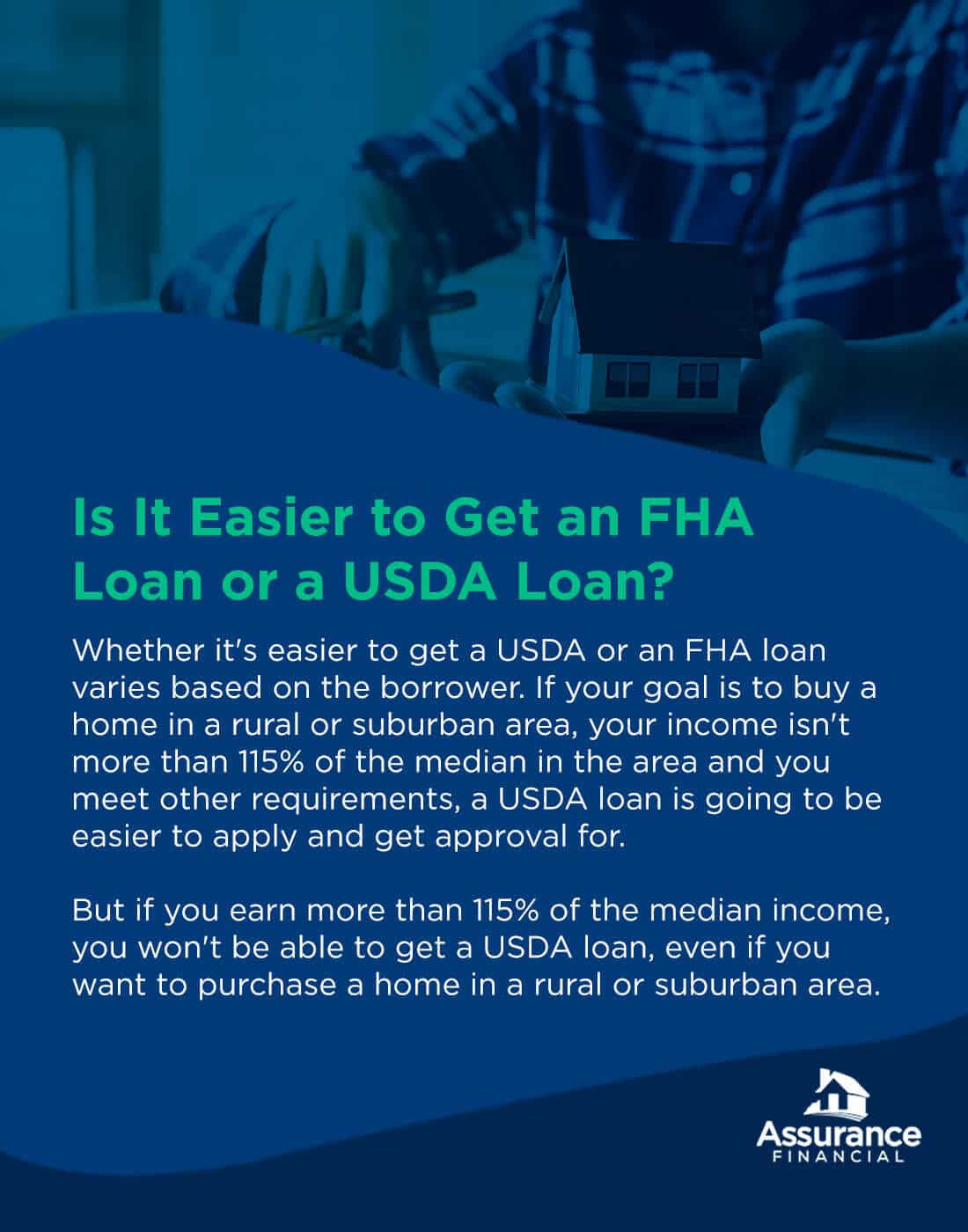Several government loan programs exist to help buyers take one step closer to the American dream of homeownership. If you’re considering buying a home and don’t think you’ll qualify for a conventional mortgage, a Federal Housing Administration (FHA) loan or a United States Department of Agriculture (USDA) loan might be right for you.
While the FHA loan program and the USDA loan program have some similarities, they ultimately have slightly different goals and different requirements. Generally speaking, USDA loans have more restrictions than FHA loans. Your income and where you want to live can influence whether an FHA or USDA loan is the right choice for you.
What Is an FHA Loan?
An FHA loan is a type of mortgage for new buyers in the United States. The FHA is part of the U.S. Department of Housing and Urban Development (HUD). It guarantees or insures the FHA loan program.
FHA loans don’t come directly from the government. Instead, they are from private lenders. The lenders have the FHA’s guarantee that it will step in and cover the cost of the loan if the borrower is unable to pay or stops making payments.
Since private lenders have insurance from the FHA, they are more likely to lend money to people who wouldn’t qualify for a conventional mortgage. FHA loans are therefore available to buyers with low credit scores and those who can’t make a down payment of 10% or more.
FHA Loan Term and Interest
FHA lenders generally offer a 15- or 30-year term. Borrowers can repay the loan early by making larger or more frequent installments than the minimum requirement.
An FHA may have a fixed interest rate, meaning it will stay the same throughout the term. Conversely, an FHA may also have a variable interest rate.
FHA Down Payments and Insurance
You must put at least 3.5% of the purchase price down when you finance your home purchase via an FHA loan if your credit score is 580 or higher. The minimum down payment is 10% for buyers with a 500-579 credit score.
In exchange for financial flexibility, the FHA requires borrowers to take out a two-part mortgage insurance policy. Part one is an upfront expense equal to 1.75% of the loan. Part two is an annual fee that varies based on the size of your down payment, the loan term and the amount of the loan. You can pay the second part once per year or divide the annual balance over 12 months. A smaller down payment results in a larger mortgage insurance premium.
The size of your down payment also affects how long you need to maintain the mortgage policy. The mortgage insurance policy remains in place throughout the loan’s term when you put less than 10% down. If you put down 10% or more, you can eliminate the premium after 11 years of consistent payment.
What Is a USDA Loan?
USDA loans, also known as Rural Development loans, make homeownership affordable and provide affordable housing in rural and some suburban areas. You can’t apply for a USDA loan if you want to purchase property in the middle of a big city or metropolitan area.
USDA Down Payments and Other Features
You don’t have to make a down payment if you qualify for a USDA loan. You will have to pay a funding fee, which acts as insurance. The amount of the fee can vary but can’t be more than 3.5% upfront and 0.5% of the average annual unpaid balance monthly.
USDA loan borrowers need to meet income requirements, which vary based on the part of the country where they want to purchase a home.
USDA loans have 30-year terms and fixed interest rates, which are set by the lender.
Types of USDA Loans
The USDA supports two types of loans.
Single Family Direct Loans are issued by the USDA. They are designed for borrowers with a low or very low income who want to purchase a home in a rural area. The loans have up to 33-year terms — and up to 38 years for very-low-income individuals — no down payment required and financial assistance for borrowers. As of 2022, Single Family Direct Loans have a fixed interest rate of 2.5%.
The other USDA loan program, the Single Family Housing Guaranteed Loan program, has some features in common with FHA loans. It’s guaranteed by the USDA and issued by approved, private lenders. Lenders who participate in the USDA loan program can have up to 90% of the loan amount insured by the USDA.
USDA vs. FHA — What Do FHA and USDA Loans Have in Common?
While USDA and FHA loans have their differences, there is some overlap between the two loan programs. Some of the features the loans have in common include:
1. Government Guarantee
Both FHA and USDA loans are guaranteed by the government. However, the agencies that guarantee the loans differ. The FHA provides insurance for lenders who participate in the FHA loan program, while the USDA backs USDA loans.
The government guarantee matters because it gives lenders peace of mind. When a lender issues a loan, it wants some reassurance that a borrower will repay it. To get that reassurance, lenders look at borrowers’ credit scores, income and assets. Generally, the higher a person’s credit score and income and the more assets they have, the less risky they look to a lender.
A borrower who doesn’t have a high credit score, substantial income or lots of assets might still be able to pay their mortgage as agreed, but a lender might hesitate to approve them. In the case of either a USDA loan or FHA loan, a government agency is stepping in to provide an extra layer of security to the lender, minimizing its risk.
The government guarantee doesn’t come free to borrowers. In the case of both an FHA and a USDA loan, the borrower has to pay mortgage insurance premiums to cover the cost of the agencies’ guarantees.
2. Availability to Buyers Who Might Have Difficulty Qualifying for Other Mortgages
Another feature FHA and USDA loans have in common is that both are available to homebuyers who might not qualify for other types of mortgages. The FHA loan program is meant for buyers who might have excellent, very good or fair credit scores and who aren’t able to make a large down payment. These buyers might have tried to apply for conventional mortgages but were turned down.
The USDA loan program is for buyers in rural or suburban areas who might not have enough income to qualify for another type of mortgage and who don’t have the down payment available for an FHA loan.
3. Fixed Interest Rates
Both USDA and FHA loan programs offer borrowers fixed interest rates. A fixed interest rate stays the same throughout the loan term. If you take out an FHA mortgage with a 3.85% rate, you’ll pay 3.85% on day one and on the last day.
There are several advantages to getting a mortgage with a fixed rate. You always know what your monthly payments will be when the rate is constant. Getting a mortgage with a fixed rate also lets you lock in a rate when they are low, without worrying that it will increase in the future.
In contrast, adjustable-rate mortgages (ARMs) have interest rates that change on a set schedule, such as every three years. The rate on an ARM can jump one day, increasing the size of your monthly mortgage payment.
USDA vs. FHA — What’s the Difference Between FHA and USDA Loans?
While there are some similarities when you compare USDA loans versus FHA ones, the mortgages come from two distinct programs. There are some other notable differences between FHA and Rural Development loans.
1. Down Payment Requirements
One of the biggest differences between a USDA loan and an FHA loan is the down payment requirement. In short, you can get a USDA loan without making a down payment. The loan program is designed to make homeownership an option for buyers who would otherwise be excluded from the process.
To get an FHA loan, you need to put down at least 3.5% of the purchase price. The general down payment requirement for FHA loans ranges from 3.5% to 10%. You can put down more, but the usual recommendation is to consider another type of mortgage, such as a conventional mortgage, if you can afford a bigger down payment. The cost of an FHA loan’s mortgage insurance can make it more expensive than other options for borrowers who can make larger down payments.
2. Location Requirements
Another notable difference between the FHA and USDA loan programs is the location restrictions the USDA loan program has. If you want to buy a home with an FHA loan, you can purchase property anywhere in the country. You can buy a four-unit place in the heart of New York City or a sprawling ranch in the middle of Montana.
That’s not the case with a USDA loan. The property you purchase with a USDA loan needs to be located in an eligible area. Eligible areas include rural parts of the country, as well as some suburban areas. You might be surprised at what counts as “rural” under the USDA’s definition, so unless you want to buy a home in a metropolitan area, it can be worthwhile to check the USDA’s eligibility map to see if your location qualifies.
3. Credit Score Eligibility
Your credit score plays a part in the approval process when you want to get a mortgage to buy a home. But, in the case of an FHA or USDA loan, it might play less of a part than it would if you were applying for a conventional mortgage.
Both loan programs have more lenient credit requirements than other mortgage programs. The USDA loan program has no set credit requirements. That said, the lender you work with might have its own set of requirements for borrowers who want to apply for a USDA loan. Often, a credit score over 640 is recommended for people who are interested in a USDA loan.
The credit requirements for an FHA loan determine the size of the down payment you can make. If your score is less than 580 but more than 500, you can qualify for an FHA loan but need to put down 10%. If your score is over 580, you can put down as little as 3.5%.
4. Mortgage Insurance Requirements
Mortgage insurance is part of the bargain whether you apply for an FHA or a USDA loan. But the amount of your mortgage insurance premiums will vary considerably depending on the program you choose.
FHA loans have higher mortgage insurance premiums than USDA loans, particularly if you make a smaller down payment. If you put down the minimum 3.5%, your monthly mortgage insurance premium will be 0.85% of the loan amount. You need to pay the premium for the entire term of the mortgage. The monthly premium is in addition to the 1.75% you paid upfront.
The required premiums, or funding fee, for a USDA loan aren’t more than 0.5% of the remaining balance and 3.75% upfront. You have to pay the monthly premium through the entire term of the USDA loan.
5. Closing Costs
With both a USDA and an FHA loan, the borrower is responsible for paying closing costs. But how the closing costs are handled can differ. With a USDA loan, you can borrow more than the value of the home and use some of the extra money to cover closing costs. That’s usually not an option with an FHA loan. Financing some or all of the closing costs can make buying a home more affordable.
An FHA loan does allow you to accept seller concessions or a seller assist. If you’re buying a home in a buyer’s market, meaning there are more houses for sale than people interested in buying, you might be able to get the seller to contribute to your closing costs. Usually, a seller assist is tougher to get in a seller’s market, when there are more buyers than homes available.
6. Income Requirements
Your income doesn’t matter if you’re interested in an FHA loan. There are no maximum or minimum income requirements, aside from being able to prove that you have an income and that it’s enough to pay back your loan. Usually, you’ll need to provide tax returns, pay stubs and proof of employment when you apply for an FHA loan.
The guaranteed USDA loan program does have income requirements. Your income can’t be more than 115% of the median income in your area. Since the cost of living and income varies considerably from state to state, some areas have higher income maximums than others. You can check to see if your income is eligible based on your location at the USDA’s website.
7. Loan Terms
The length of your mortgage can vary depending on whether you go for a USDA or FHA loan. FHA loans are available in 15- or 30-year terms. Depending on your income and goals, there are advantages and disadvantages to choosing a 15- or 30-year mortgage.
A mortgage with a 15-year term typically has a lower interest rate than a 30-year mortgage. But your monthly payments are usually higher with a 15-year loan. Another benefit of a 15-year mortgage is that you pay it off more quickly. Mortgages with 30-year terms usually have slightly higher interest rates but lower monthly payments, helping to make buying a home more affordable.
If you want a USDA loan, you can’t select a 15-year term.
8. Home Requirements
The requirements for the home you purchase with a USDA or FHA loan vary slightly. In addition to meeting location requirements, a home purchased with a USDA loan needs to meet certain habitability requirements. Most notably, it needs to be safe to live in. The house also has to act as your primary residence.
The home you purchase with an FHA loan needs to meet HUD health and safety standards. An appraisal is part of the loan application process. During the appraisal, the appraiser will determine more than the market value of the home. They’ll also assess its quality and whether it meets safety requirements.
While you do need to live in the home you purchase with an FHA loan, houses with multiple units, such as two or three-unit properties, are eligible for FHA mortgages.
A home inspection isn’t required for a USDA loan. But it’s a good idea to get an inspection before you purchase a home to ensure there aren’t major, hidden concerns with the property. You can negotiate with the seller if an inspection turns up any issues.
Is It Easier to Get an FHA Loan or a USDA Loan?
Whether it’s easier to get a USDA or an FHA loan varies based on the borrower. If your goal is to buy a home in a rural or suburban area, your income isn’t more than 115% of the median in the area and you meet other requirements, a USDA loan is going to be easier to apply and get approval for.
But if you earn more than 115% of the median income, you won’t be able to get a USDA loan, even if you want to purchase a home in a rural or suburban area.
[download_section]
Is an FHA or a USDA Loan Better?
Whether an FHA or USDA loan is better or not also depends on the borrower and their specific circumstances. USDA loans are ideal for borrowers with lower incomes who want to buy in rural areas. FHA loans are often ideal for borrowers who have a small down payment saved and credit scores that aren’t high enough to get a low interest rate on a conventional mortgage.
How to Decide Between FHA and USDA Loans
Some of the questions to ask when deciding between an FHA or USDA loan include:
- Where do you want to purchase a home? You can choose the FHA or USDA loan if you want to purchase a rural or suburban home. The USDA loan is exclusively compatible with homes in rural areas and select suburban regions.
- How much can you afford to put down? If you don’t have anything saved for a down payment, a USDA loan is likely the better option.
- Do you have enough for closing costs? The USDA loan covers up to 100% of the property’s appraised value. With a large enough down payment, you may have room to roll in closing costs.
- How long do you want to have a mortgage? While both USDA and FHA loans offer 30-year mortgages, only FHA loans give you the option of a 15-year term.
- What’s your income? If your income is higher than 115% of the local median, you would only qualify for the FHA loan.
Why Trust Us for FHAs and USDAs?
Assurance Financial is an experienced financial agency that has helped numerous buyers choose the ideal borrowing option for their circumstances. We use our experience and analytical skills to help customers determine if an FHA or USDA loan complements their financial situations and lifestyle preferences. Then, through a seamless online application system, we streamline the process of connecting borrowers with the money they need to purchase a home.
Our end-to-end services and relationship-driven approach have earned us an average rating of 4.98 stars across thousands of reviews.
Apply for a Mortgage With Assurance Financial Today
Apply today to experience the services that make us a trusted provider of FHA and USDA loans.
For more on our mortgage options, find an Assurance Financial adviser near you.
Linked sources:
- https://assurancemortgage.com/fha-loans/
- https://www.consumerfinance.gov/owning-a-home/loan-options/fha-loans/
- https://assurancemortgage.com/everything-need-know-fha-loans/
- https://www.hud.gov/sites/documents/15-01MLATCH.PDF
- https://assurancemortgage.com/usda-loans/
- https://www.rd.usda.gov/programs-services/single-family-housing-programs/single-family-housing-direct-home-loans
- https://www.rd.usda.gov/programs-services/single-family-housing-programs/single-family-housing-guaranteed-loan-program
- https://www.ecfr.gov/current/title-7/subtitle-B/chapter-XXXV/part-3555#p-3555.107(g)
- https://assurancemortgage.com/fixed-interest-rate-vs-adjustable-interest-rate/
- https://assurancemortgage.com/what-is-down-payment-home-loan/
- https://assurancemortgage.com/what-is-a-usda-loan-how-to-apply/
- https://eligibility.sc.egov.usda.gov/eligibility/welcomeAction.do
- https://assurancemortgage.com/important-credit-score-for-home-loan/
- https://assurancemortgage.com/buyers-vs-sellers-market/
- https://eligibility.sc.egov.usda.gov/eligibility/incomeEligibilityAction.do?pageAction=state
- https://assurancemortgage.com/15-vs-30-year-mortgages/
- https://www.rd.usda.gov/files/3550-1chapter05.pdf
- https://assurancemortgage.com/finding-right-mortgage-loan-for-you/
- https://assurancemortgage.com/apply/



